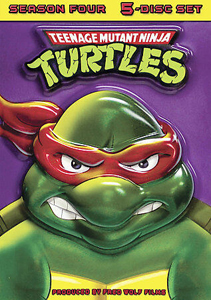In the first CBS episode, as the Turtles (rather slowly) recognize that a giant fly footprint belongs to Baxter Stockman, they muse about who else might be lurking in the sewers, mentioning the Rat King and Leatherhead.
The writers – led by David Wise, who writes the first half-hour of every Saturday morning hourlong block amid these 13 episodes (the first half of CBS’ 26-episode Season 4) – signal to viewers that they’re getting back to action-figure shilling. This mission was set aside during Season 4’s 13 syndicated episodes, which aired roughly simultaneously in Fall 1990.
And they do get back to it – sort of. “Teenage Mutant Ninja Turtles” is notorious for not caring too much about continuity, and missing opportunities to expand on fan-favorite supporting characters. This batch is a case in point as it introduces decent characters then snatches them away.

“Teenage Mutant Ninja Turtles” Season 4, episodes 14-26 (1990)
CBS
Episodes: “Son of Return of the Fly II” (14), “Raphael Knocks ‘Em Dead” (15), “Bebop and Rocksteady Conquer the Universe” (16), “Raphael Meets His Match” (17), “Slash, The Evil Turtle from Dimension X” (18), “Leonardo Lightens Up” (19), “Were-Rats from Channel 6” (20), “Funny, They Shrunk Michelangelo” (21), “The Big Zipp Attack” (22), “Donatello Makes Time” (23), “Farewell, Lotus Blossom” (24), “Rebel Without a Fin” (25), “Rhino-Man” (26)
Producer: Fred Wolf
Writers: David Wise (14, 16, 18, 20, 22, 24, 26), Jack Mendelsohn (15), Charles M. Howell IV (17), Dan DiStefano (19), Michael Edens (21), Dennis Marks (23), Michael Reaves (25)
Raph gets a girlfriend
It includes the debuts of action-figure characters Mona Lisa in “Raphael Meets His Match” (17, Charles M. Howell IV) and Slash in “Slash, the Evil Turtle from Dimension X” (18, Wise) – plus the return of Baxter-Fly in “Son of Return of the Fly II” (14, Wise) and the Rat King in “Were-Rats from Channel 6” (20, Wise).
Also, we get the debut of “should’ve been action figure” Ray the fishman in “Rebel Without a Fin” (25, Michael Reaves) and the return of “should’ve been an action figure” Lotus Blossom in “Farewell, Lotus Blossom” (24, Wise). NECA made a Lotus figure decades later, as it also did with the gang’s human teenage pal Zach the Fifth Turtle, who pops up again in “Bebop and Rocksteady Conquer the Universe” (16, Wise).
Remarkably, we never see Mona Lisa, Lotus Blossom or Ray again in the cartoon. The biggest loss is Mona Lisa, a super-cute love interest for Raph who is voiced with spunk by guest actress Pat Musick, who has great chemistry with Raph actor Rob Paulsen as the duo meets at a yacht party.

While it’s too bad that the plot isn’t great – the flashback to Mona’s mutation into a salamander by sci-fi pirate Captain Filch is bland – “Raphael Meets His Match” is a rightly a cult favorite, even ranking among ToonGal12’s top five episodes.
Leo’s love interest returns
While Raph and Mona are giggle-worthy, Leo and Lotus were too in her stronger Season 3 debut “Beware the Lotus,” but the writers eschew that here. In “Farewell, Lotus Blossom,” Lotus exchanges lines with Leo more than the others, but that’s the extent of it. As with Usagi Yojimbo in his two episodes, I expect calm Japanese wisdom from Lotus, but she is easily manipulated by Shredder.
The title “Farewell, Lotus Blossom” is sadly accurate, but in “Raphael Meets His Match,” the Turtles surmise they’ll see Mona again. They make that same wrong assumption in “Rebel Without a Fin” with Ray, who has an interesting real-world creation story. He was supposed to be Ray Fillet (a.k.a. Man-Ray), but Mirage’s Ryan Brown – tired of the cartoon making his good guys into villains (Leatherhead, Slash, etc.) – successfully quashed that notion this time.
Late in production, Ray was creatively changed into a fish man with the powers of eels, octopi, scorpionfish and blowfish – but he unfortunately retained the name Ray, resulting in two aquatic mutants with that name in “TMNT” lore.
Perhaps because the script is flat – Ray’s motivation for doing the bidding of the mad scientist who created him is unclear – Krang actor Pat Fraley gives Ray a totally nonchalant, seen-it-all mobster voice. His end goal is to be left alone, a rare motivation for a villain, and a viewer can see DNA of Man-Ray in there. In the Archie comics, the peaceful Man-Ray is big on preserving nature in an unspoiled state.
Showy episodes
The first episode in each block tended to be the “bigger” one. I remembered specific lines from “Son of Return of the Fly II” — with a sentient computer putting up with nutso Baxter until he can get his own body – and the Slash episode. “Slash, the Evil Turtle from Dimension X” might’ve influenced the second movie’s “Go, play, have fun!” sequence as the dimwitted turtle vandalizes the city for a corporate villain who promises to acquire lots of plastic palm trees for him.
“Slash” and “Were-Rats” end with epic battles on flying vehicles (a space shuttle in the former case!) and “The Big Zipp Attack” (22, Wise) features metal-eating aliens who multiply like Gremlins. But generally, this batch doesn’t go for straight rip-offs of popular movies; I sense the writers’ intent to be slightly more original than before, and to have the plots make slightly more sense.
Emphasis on slightly. The writers are big on the trope of mad scientists. Ray is created by Dr. Polidorius (whose name is amusingly pronounced wrong by the Turtles – “Polyana, Polyurethane, Polytechnic,” etc.). Baxter’s nastier identical brother Barney Stockman schemes to drive New Yorkers mad with laughter in “Raphael Knocks ’Em Dead” (15, Jack Mendelsohn), and Professor Lloyd Psycloid steals Don’s time-stopping invention in “Donatello Makes Time” (23, Dennis Marks).
Villains who aren’t mad-scientist stereotypes nonetheless wield crazy inventions, like the Napoloen-complex-afflicted Talbot Breech in “Funny, They Shrunk Michaelangelo” (21, Michael Edens) and the “Simpsons”-esque mad Texan J. Gordon Hungerdunger in “Rhino-Man” (26, Wise).
Bebop and Rocksteady conquer the storylines
But you’ll notice I’m not mentioning Shredder and Krang as often among the villains, and that’s generally a good thing. They’re still the main baddies, but they’re not the only baddies. That said, Bebop and Rocksteady do shine in this batch. By making them just slightly smarter than usual, they are slightly funnier than usual.
In “Bebop and Rocksteady Conquer the Universe,” they show the remarkable initiative to use the device-of-the-week for their own benefit, rather than for their bosses’. This leads to amusing scenes of everyone – including Krang and Shredder – cowering under the effects of the anxiety ray.
In “Rhino-Man,” they reluctantly become superheroes. The line about the absurdity of a citywide superhero contest is not intended to be ironic, as this was before the Stan Lee-hosted “Who Wants to Be a Superhero?” (2006-07). Speaking of the Marvel Comics legend, the more Bebop mentions his love for comic books, the more I suspect Barry Gordon is doing an exaggerated and gruffer Stan Lee impression.
Focus on individual Turtles
In addition to Bebop and Rocksteady, the CBS episodes aim to give more attention to each individual Turtle, as you can tell by the titles of most of the episodes in the second half-hour. I remembered these being lighter, forgettable episodes, and that’s true except for “Raphael Meets His Match.”
“Raphel Knocks ’Em Dead” is a missed opportunity to slather the script with dad jokes, “Leonardo Lightens Up” (19, Dan DiStefano) is exactly what you think it is, and “Funny, They Shrunk Michaelangelo” manages to be a blander miniaturization tale than Season 2’s “The Incredible Shrinking Turtles.”
It has one good Easter egg, though: Mikey befriends a stray cat at the end who resembles Klunk. Of course, this cat – like Mona Lisa and Ray the fish man — never returns.

